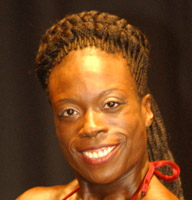THE BILL DOBBINS FEMALE PHYSIQUE WEBZINE/GALLERY
MS. OLYMPIA BODYBUILDING
FINALS 2005
To Be Replaced By A Fitness Model
Contest!
How Did Women's Bodybuilding Get To This State???
By Bill Dobbins
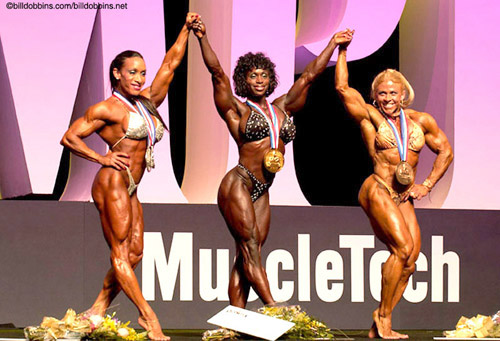 |
The Lightweight Finals of the 2004 Ms. Olympia The winner weighed 120 pounds. But there are no more weight classes in FBB pro bodybuilding... and the finals for 2005 are being replaced in the Friday night show by a "Model Search" |
According to the ticket information page of the official Olympia
Weekend 2005 website, the finals of the Ms. Olympia
will not be held with the Olympia Fitness and Figure competitions in Orleans
Theater on Friday night, October 14th, but instead will be relegated to Saturday
the 15th on the floor of the Olympia Expo. In
place of bodybuilding on Friday night, the organizers have scheduled the
finals
of the "Model Search" competition – a straightforward
beauty contest.
One IFBB official questioned confirms that this change originated with AMI/Weider, the promoter of the Olympia, rather than from the federation, although the IFBB has evidently agreed to accept this scheduling of what, at least until now, has been its premier women's bodybuilding pro competition. This scheduling not only represents a clear demotion for the female bodybuilders and lack of support for the sport of women's bodybuilding.
At least it appears the Ms. Olympia finals and the prejuding for the Mr. Olympia will not take place simultaneously. According to Rob Wilkins of the IFBB, the finals for the Ms. Olympia will be at 10 AM and the Mr. Olympia prejudging is scheduled for 2PM - and shuttles will be available to the Orleans Arena. The organizers evidently didn't want anything to interfere with ticket sales for the men's prejudging.
However, this change in scheduling of the Ms. Olympia should not come as any great surprise, coming as it does in the wake of the recent IFBB ruling that women physique competitors will be required to cut back on their "muscularity" by 20% (however that is supposed to be accomplish or judged). There is also the fact that many in the IFBB and at AMI/Weider , which promotes the Olympia weekend, are unhappy with Iris Kyle having won the Ms. Olympia title in 2004.
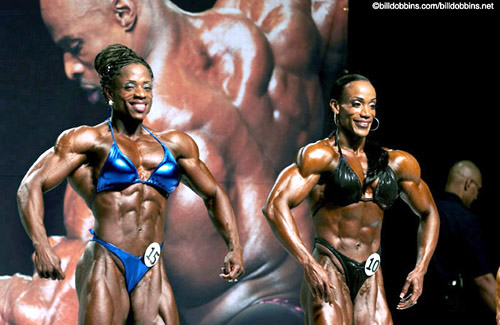 |
Iris Kyle and Lenda Murray during
prejudging of the 2004 Ms. Olympia. Many feel that Iris' victory helped trigger the "demotion" of IFBB pro female bodybuilding. |
Even though there has been no real attempt to market any female bodybuilders to the general public (or even to feature them in Muscle & Fitness or Flex Magazines) the feeling seems to be that Iris is not somebody who can be used to promote the sport to a mass audience. The same thing happened a few years ago when Kim Chizevsky defeated Lenda Murray for the Olympia title. And yet when Lenda did return to competition and win, no effort was made to use her beauty and sleek muscular body to promote IFBB bodybuilding for women outside (and hardly inside) the industry.
In fact, the Weider magazines haven't made much effort to promote any of the female physique competitors. Last year, prior to the Olympia, Muscle & Fitness featured an NFL cheerleader on the cover rather than Ms. Olympia Fitness or Figure or any of the other pro women. So much for marketing the women to the general public.
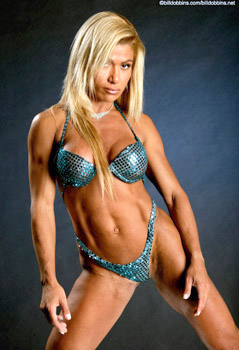 |
| Flavia Crisos of Brazil is NABBA World Fitness Champion - and even more ripped than this when in contest shape. How did we get to the point where beautiful female muscle is more acceptable in South America and Europe than it is in IFBB pro female physique contests in North America? |
The gradual but obvious deterioration in the treatment of women bodybuilders by the IFBB is all the more ironic – if not tragic – because we are in the midst of what appears to be the golden age of women's sports. Until Billie Jean King and then Martina Navratilova came along, women's tennis was a ladylike affair that didn't have much public appeal. Now with competitors on the scene like the Williams sisters, tennis for women has an equal appeal to fans as the men do. Thanks to competitors like Olga Korbut and Nadia Comaneci, the television ratings for women gymnasts in the Olympics easily exceeds that of the male gymnasts.
The WNBA is thriving, thanks to promotable stars like Lisa Leslie and Misty May and Kerri Walsh in women's beach volleyball were one of the hits of the last Olympics. Even the LPGA, which has done well over the years but has still had a narrow audience appeal, has increased in popularity thanks in part to the star power of Annika Sorenstam. There is even growing interest in boxing for women, which would seem like the least likely of sports in which women might excel.
Danica Patrick's 4th place finish at the 2005 Indianapolis 500, a race in which she held the lead just a few laps before the finish, boosted television ratings amazingly and proved (as did Annika Sorsentam's participation in a men's PGA tour even, even though she failed to make the cut) that there is a market for women in sport if the women and the sport are presented properly.
Brandi Chastain took her shirt off and waved it over her head after her team won the Women's World Cup Final and suddenly girl's soccer teams all over the country and the world were flooded with eager new prospects – and it didn't hurt the sales of sports bras either.
The examples of how well women's sports are thriving are countless, thanks in part to increasing television coverage and the influence of Title IX, passed by Congress in 1972, which stated
"No person in the United States shall, on the basis of sex, be excluded from participation in, be denied the benefits of, or be subjected to discrimination under any education program or activity receiving Federal financial assistance."
The Olympics have also been strong supporters of women's athletics. From the Olympic charter:
"Any form of discrimination with regard to a country or person on the grounds of race, religion, polics, GENDER or otherwise is incompatible with belonging to the Olympic Movement"
Evidently, IFBB President Ben Weider, who has worked for so long to have bodybuilding become an Olympic sport, has now given up on that goal, since the ongoing discrimination against women bodybuilders by the federation would disqualify it from Olympic participation.
Actually, although there has been resistance to female developing their muscles for aesthetic purposes since the earliest days of modern bodybuilding for women, it has been Ben Weider's Olympic ambitions which have probably been the single most influential factor in creating the problems women bodybuilders now face in the IFBB. Ben Weider became convinced that the existence of pro female bodybuilders – evidently more than the problem of no steroid testing at the pro level of the sport – that was causing the IOC to resist including bodybuilding as an Olympic sport.
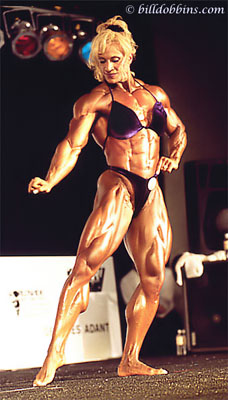 |
| Kim Chizevsky at the '99 Ms. Olympia |
After Kim Chizevsky won her 4th Ms. Olympia title in 1999 (after complying with requests that she come in with a sleeker physique, less depletion showing on her face and better make-up) the IFBB issued the 2000 "guidelines" for female bodybuilding which stated the judges would start making things like make-up and overall presentation a more significant part of the scoring and would count off for "excessive" muscularity. Imagine putting out an official memo regarding judging bodybuilding for men!
The first few 2000 contest for women turned out to be disasters because of these "guidelines." The women bodybuilders at the Ms. International represented the most out-of-shape lineup I can recall in modern pro bodybuilding for women. This had happened before, after Bev Francis had come close to winning the 1992 Ms. Olympia and Ben Weider put out a special modification of the rules to deal with this "problem." As a result, the competitor who should have finished first or second at the Jan Tana that year was placed 11th because, in the words of one judge, she was "too muscular for the lineup." Eventually, an update of the rule changes was enacted that "reinterpreted" scoring standards so that judges would no longer be encouraged to score women poorly for simply being better and more advanced bodybuilders than those in a lineup against whom whey were being compared.
The impact of the 2000 "guidelines" on the fan base of the sport was so bad that the IFBB began to realize they were drastically hurting ticket sales for FBB contests. As a result, the judges simply starting ignoring these rule modifications and went back to the more traditional way of scoring.
A Few Words From Napoleon on Women's Equality: "Nature intended women to be our slaves. They are our property; we are not theirs. They belong to us, just as a tree that bears fruit belongs to a gardener. What a mad idea to demand equality for women! Women are nothing but machines for producing children." Napoleon Bonaparte from the Dictionary of Outrageous Quotes, compiled and introduced by C.R.S. Marsden. 1988 copyright. Published by Salem House Publishers. |
Unfortunately, the National Physique Committee (NPC), which is the IFBB affiliated federation that governs amateur physique competition in the United States, also tried to implement these guidelines with simarly disastrous results. Judges at lower level contests routinely began taking the first place competitors in each class and dropping them down to 3rd because they were "too big," according to the guidelines. When you are talking about a contest at the level of the Jr. USA this application of the rules was patently absurd.
At the USA that year, one of the favorites in bodybuilding placed 7th. I asked one of the judges, in confidence, where he would have placed her if it weren't for the guidelines. "Oh," he said, "I'd have given her the whole show."
In recent years, we've seen virtually no support given female bodybuilding by the federations, the officials or (taking their cue from the powers-that-be) the physique magazines. Sponsors have been discouraged from putting up money for female bodybuilding contests. The emphasis on figure competition has helped convince many FBBs to switch categories, thinking that somehow slimming down and losing muscle would turn them into fitness supermodels. That hasn't worked for ANY of them. Since there is nothing you can do to change your basic body-type and proportions, figure is the most genetically demanding of all three types of female physique competition – and genetically-gifted bodybuilders with their compact bodies and fully-shaped muscles need not apply.
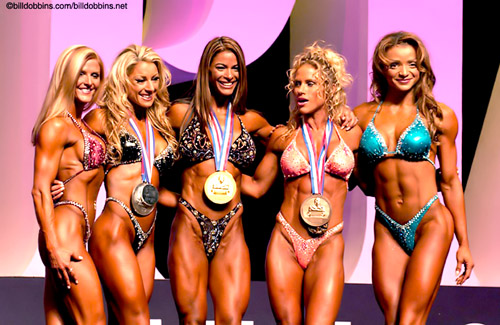 |
The Ms. Olympia Figure 2004 Finalists. Will figure evolve into the women's bodybuilding of the future? |
The federations may have also have made somewhat of a miscalculation where figure competition is concerned. While the competitors are no doubt beautiful and attractive, they do not generally create the kind of long-term fan appeal that you find with female bodybuilders. The top women in bodybuilding have far more dedicated, long-term fans than do women in fitness or figure. Fans who will spend money to buy tickets, signed photos and magazines in which they are featured. There are a few non-bodybuilding competitors who achieve great popularity – Monica Brant and Timea Majorova, for example – but it is common to be at an Expo and see crowds paying relatively little attention to figure champions like Davana Medina and Jenny Lynn (two of my favorites).
IS PPV TV THE ISSUE? |
As to competition, exactly how many quarter-turns can you stand to sit through and still pretend to be interested? Especially when there are not only no objective standards for judging figure (or fitness) but the judges frequently maintain very little consistency from one contest to the next. A competitor who finishes 15th in one event can make the top five in the next looking exactly the same. Or vice-versa.
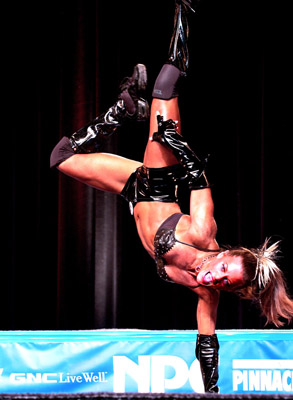 |
| Women are leaving fitness for figure because the routines are too difficult - and too dangerous. |
I'm focusing on figure vs. bodybuilding rather than including fitness because the current policies of the federations are rapidly destroying fitness – especially on the amateur level. As long as women have to be accomplished gymnasts to have a high probability of succeeding in fitness, more and more women in this category will defect to figure – where they are usually at the same kind of genetic disadvantage (having compact rather than elongated physiques) as are the bodybuilders. At the 2005 NPC California Championships, female bodybuilding was weak but fitness was virtually non-existent. Only two women entered fitness at this year's Cal.
It's a further irony that bodybuilding for women is being treated so poorly by the IFBB/NPC (although the NPC is generally far more supportive of the FBBs) at a time when the female bodybuilders have had a virtually revolutionary effect on both women's sport and our culture as a whole. Look at the muscles on women sprinters like Marion Jones or tennis champ Serena Williams. They didn't develop these physiques by running or hitting a tennis ball. They built their physiques in a gym! In the 1970s, when modern bodybuilding for women began, comparatively few athletes did a lot of weight training and almost no women. Nowadays, it is difficult to find any athlete in any sport who doesn't do at least some weight training. And those who don't find themselves at a distinct disadvantage.
And where did they get the inspiration and motivation to develop stronger and more muscular physiques with weight training? From the example of female bodybuilders, beginning in the late 1970s.
Look at actresses like Linda Hamilton in Terminator II or Angela Bassett in What's Love Got To Do With It? This is what Muscle & Fitness Hers had to say about Angela's physique:
| Remember Angela Bassett in Tina Turner's autobiographical movie, "What's Love Got to Do With It?" She had a body that would make even Tina--no weakling herself--envious. Angela had it going on, and her arms were definitely the prize of the package. Yet the secret to awesome arms is really no secret at all. If you work to tighten and tone those triceps, you'll see your arms go from mediocre to magnificent. |
Women did not display this degree of muscularity and definition prior to the advent of modern bodybuilding for women. And it pays to remember that "weight training" and "resistance training," which most say they are doing, are just euphemisms for the kind of progressive-resistance training developed and practiced by serious bodybuilding competitors, both men and women.
Response From A Vascular Surgeon |
Bodybuilding has changed the face of our culture, but doesn't get credit for it. But while star athletes and muscular actors like Sly Stallone or Jean-Claude Van Damme will give credit to Arnold Schwarzenegger and other champion bodybuilders for inspiring them to train and develop their bodies, the contribution of female bodybuilders is largely ignored.
Remember, the only reason fitness and figure exist is because women bodybuilders came along first. Prior to the FBBs, it was not generally understood that (at least some) women could get big, strong and muscular by hard training and proper diet. Charles Gaines, author of Pumping Iron - the book that helped publicize both bodybuilding and Arnold - has pointed out that aesthetically developed muscular women are an entirely new archetype in human culture, something "new under the sun," and you can go back in history as far as you want any you won't find the kind of examples of muscular women that you do of muscular men.
 |
| Rachel McLish, some 10 years after retiring from competition. Many don't recall that she was one of the most ripped and muscular FBBs of her day. |
The cultural shock of female bodybuilding has been immense and ongoing. In the early 1980s, the fact that the women weren't that big – and we had very promotable champions like Rachel McLish and later Cory Everson – meant that women who were considered "too manly" looking were criticized more than the sport in general. But as I've pointed out, everybody love kittens but not everyone likes cats. As the women continued to develop and become bigger and more muscular, we began to see a lot of negative reaction – both from the public and on the part of the federations themselves.
Oddly, the critics of female muscle never seem to realize that their dislike of these physiques is based on a kind of sliding scale. They don't like today's muscular body but s ay they prefer how the women looked some number of years ago. Then time goes by and they still don't like the contemporary physiques - but the bodies "from the past" they say they prefer are the very ones they once claimed were "too extreme."
Witness the fact that many of the women in figure and fitness nowadays, praised for their beauty and aesthetics, are more muscular and have more definition than did some of the FBBs from not that many years ago.
So what about those who recommend that women bodybuilders simply stop getting bigger and more muscular? The problem here is that bodybuilding, for women or men, is actually a sport – unlike fitness or figure. And one of the characteristics that define a sport is that it is progressive. That is, the competitors keep getting better and records keep being broken. If an activity isn't progressive, it isn't a sport.
 |
This is what you see on the official
Olympia page - NO FEMALE BODYBUILDERS! Somebody has forgotten IFBB stands for International Federation of Bodybuilders. |
Could Bill Pearl, Larry Scott or Arnold Schwarzenegger, at their very best, compete successfully against Ronnie Coleman? Of course not. All athletes, no matter the sport, can only be compared realistically to their contemporaries. Nobody would think that Jesse Owens, who dominated the Olympics in 1936 (to the chagrin of Adolph Hitler) would have a chance against today's sprinters if somehow a time machine could make that match-up possible.
So women's bodybuilding began with Rachel McLish and progressed to Cory Everson, Lenda Murray and Kim Chizevsky – maybe the best their has ever been in terms of stage competition. What is amazing about bodybuilding for women is how little progress in size and muscularity there has been, not how much. A "big man" has gone from being 235 pounds to 265 in just a few years and now we have giants of 290 to 310 pounds on the Mr. Olympia stage. But 15 years after the reign of Cory Everson the women bodybuilders are hardly much bigger or more muscular.
This lack of progress among the top women when it comes to muscle mass is as clear a sign as any that the development has been stifled. And the negativity the sport faces does not come from the fans. Fill a theater full of fans of women's bodybuilding and they want to be thrilled and excited by lots of fantastic, beautiful muscle. Watch a competition and you'll see one competitor after another comes out to lukewarm response until somebody really muscular and defined hits the stage and starts hitting shots.
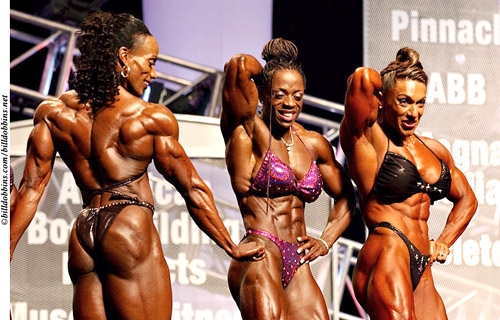 |
Bodybuilding fans - whether watching
men or women - come alive when they see MUSCLE! Endless quarter turns do not create the same kind of excietment. |
Bodybuilding is bodybuilding, whether for men or women. It's about the maximum muscular development possible in accordance with the traditional standards of the sport. It is the "grand opera" of the body. Opera singers have loud voices but those voices have to be beautiful as well. But that beauty is that of opera, not pop music. In the same regard, the bodybuilding physique has to be big and muscular, but also beautiful – but that beauty is not that of runway models, GQ, Playboy or anything else.
The IFBB says it wants to see female bodybuilders who are promotable to the general public – even though there hasn't been any mass interest in figure or fitness. At the same time, after years of effort to introduce weight divisions into pro female bodybuilding (such as are used in amateur competition), the IFBB suddenly reversed itself this year and declared there would be no weight divisions for pro FBBs in the future because, as one official stated "the women and the men should have the same rules."
It is news to me that the IFBB thinks the men and women should be treated the same, after years of "guidelines" and "20%" rules. But actually they have it backwards: the men and women should BOTH have weight classes so that smaller competitors of both genders should have a chance to win titles. There are plenty of bodybuilding fans who already consider most of the current top pros to be "steroid freaks." With top men weighing in the neighborhood of 300 pounds, where are the Frank Zane, Franco Columbu or Shawn Ray's of the future going to come from?
And with no weight divisions in women's pro bodybuilding, smaller and more aesthetic women – the ones the federation says it wants to see – have no chance in competition. So the women will all be motivated to "bulk up" and get as big as possible to compete against the bigger, 170 pound competitors – which is exactly the opposite of what the federation claims needs to happen.
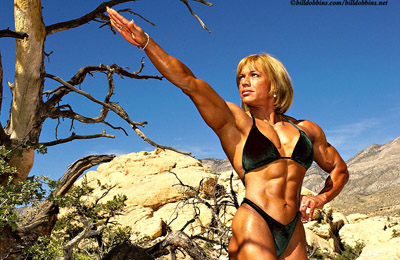 |
| Juliette Bergmann came out of retirement to compete in the Ms. Olympia SPECIFICALLY because the IFBB intoduced weight divisions for women. |
Juliette Bergmann will have no reason ever to come out of retirement again (which she did a few years ago specifically because of the use of weight divisions) and 129 pound Dayana Cadeau need leave no more room on her shelves for championship trophies.
In spite of all this, bodybuilding for women will survive in some form because it is a fundamental sport. Developing muscles to the aesthetic extreme is as basic to human nature as trying to run as fast, jump as high or throw as far as possible or see how much weight you can lift. Maybe the category of female bodybuilder will disappear in some competitions – although the IFBB World Women's Amateur Bodybuilding Championships are still attracting women competitors from all over the world. Maybe figure will continue to develop and everyone will gradually get used to their greater muscularity and definition or time so that they will become the new bodybuilders.
After all, although figure and fitness are not sports, the women in these events ARE bodybuilders - they use the same techniques as to the bodybuilding women, only modified somewhat to achieve different goals. When fitness and figure are televised, the audience usually thinks they are watching bodybuilding. Perhaps that's why the Weider magazines feature so few female physique compititors of any type and are replacing the Ms. Olympia in the Friday finals with an event designed to recruit non-muscular women - a Model Search.
But whatever happens, bodybuilding in this era remains THE ONLY MAJOR SPORT THAT CONDONES GENDER DISCRIMINATION AGAINST WOMEN – and history will likely indentify those in positions of power in the federations today as the ones who tried to – and perhaps succeeded in– killing the sport of female bodybuilding.
Express your Opinion To This
Website
All inquiries regarding the
IFBB Professional Division should be directed to: Note: Comments, suggestions and complaints
will carry more
|
